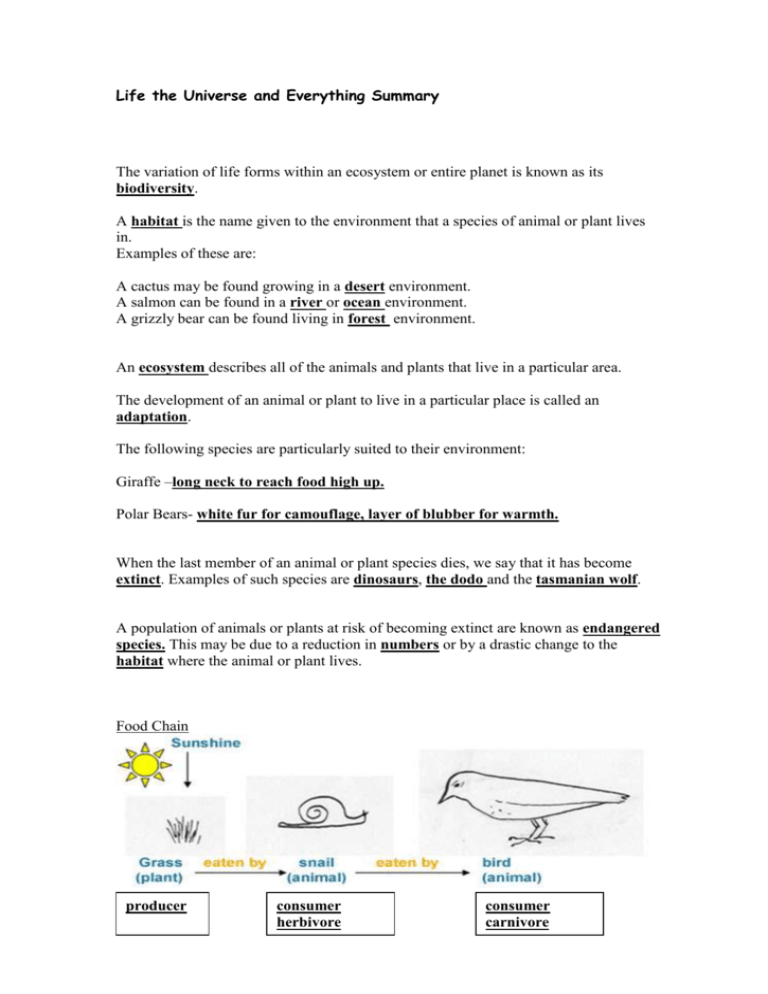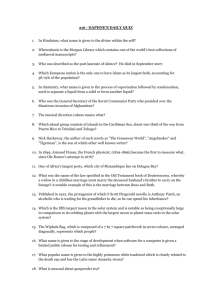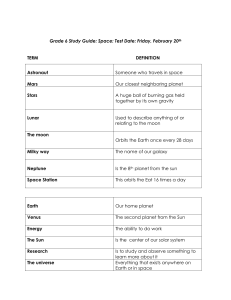Life the Universe and Everything Summary
advertisement

Life the Universe and Everything Summary The variation of life forms within an ecosystem or entire planet is known as its biodiversity. A habitat is the name given to the environment that a species of animal or plant lives in. Examples of these are: A cactus may be found growing in a desert environment. A salmon can be found in a river or ocean environment. A grizzly bear can be found living in forest environment. An ecosystem describes all of the animals and plants that live in a particular area. The development of an animal or plant to live in a particular place is called an adaptation. The following species are particularly suited to their environment: Giraffe –long neck to reach food high up. Polar Bears- white fur for camouflage, layer of blubber for warmth. When the last member of an animal or plant species dies, we say that it has become extinct. Examples of such species are dinosaurs, the dodo and the tasmanian wolf. A population of animals or plants at risk of becoming extinct are known as endangered species. This may be due to a reduction in numbers or by a drastic change to the habitat where the animal or plant lives. Food Chain producer consumer herbivore consumer carnivore In a food chain green plants are known as producers as they can make their own food. Animals are called consumers as they get their food by eating plants or other animals. Animals which eat plants only are called herbivores. Animals which eat other animals are called carnivores. The feeding relationships between animals and plants in a particular ecosystem can be shown in a food web. Plants are important for life on earth because they produce__oxygen_____ gas and they produce carbohydrates which animals use as a _____energy______ source. Three carbohydrates produced by plants are___glucose/sugar___, ___cellulose___ and starch. Iodine solution is used to test for ___starch_ , Benedicts solution is used to test for _glucose/sugar___ and Shulzes solution is used to test for cellulose. Photosynthesis is when plants use _light__ energy to make carbohydrates. _Carbon__ _dioxide__ and water are the raw materials for photosynthesis. The main products of photosynthesis are __oxygen__ and glucose. Light and _chlorophyll___ are also needed for this reaction. This can be written as an equation……… Light CO2 + H2 O → Glucose + O2 Chlorophyll Chlorophyll is the pigment that makes _leaves__ green and traps light energy. Chlorophyll pigment is found in __chloroplasts___ in plant cells. Testing a leaf for starch using iodine can be used to investigate the products of photosynthesis. Oxygen is a waste product of photosynthesis. Cabomba is an aquatic plant, counting the number of __bubbles_ produced per minute can be used to measure the rate of photosynthesis. The world population is _increasing_____so the demand for food production from crops is also increasing. The productivity of plants including crop yield can be affected by lack of nutrients. Important plant nutrients include nitrogen, _phosphorus__ and _potasssium__. Farmers can add artificially produced __fertiliser_ to the soil. Organic farmers use fertiliser made from animal waste. Plant growth can also be affected by inhibitors including numerous pollutants such as acid rain_____. Other important agricultural chemicals are use to control pest species: _herbicides__kill weeds, _insecticides kill insect pests and fungicides kill fungi__ Biological pest control can also be used to improve crop plant productivity. The use of ladybirds to control _aphids__ numbers is a good example. Agricultural chemicals are very important however if overused they can cause potential harm Fertilisers washed into rivers can result in algal growth and cause a lack of __oxygen_ for other species Pesticides can harm beneficial species as well Some toxic chemicals enter food __ _chains_ and affect biodiversity. DDT is one example of a pesticide that had major effects on the top _consumers_ in food chains. Genetically modified (GM) crops are a potential solution to provide enough ___food_ for an ever increasing world population. Complete the passage below by choosing from the list of words given. Use each word or phrase once only. galaxy moon planet solar system star gas universe The diagram shows our solar system. At the centre is the Sun. The Sun is a gigantic ball of gas producing energy by nuclear reactions. The Earth is a planet which orbits the Sun. The Earth has one natural satellite orbiting around it, called the moon. The Sun is an example of a star. Millions of these bodies like our Sun are found in a galaxy. All of space is known as the universe The 4 main features of OUR solar system are a sun, planets, moons & asteroids. The Universe is made up of millions of galaxies surrounded by space A STAR is a massive ball of gas (plasma) held together by gravity. It produces energy by nuclear reactions. A moon is a natural satellite which orbits around a planet A planet is a body orbiting a star and large enough to have its own gravity. A galaxy is a system of millions of stars. The DAY of a planet is the time taken for a planet to completely turn round on its axis. The YEAR of a planet is the length of time taken for a planet to completely orbit a star (the sun in earths case) The FIVE main conditions that are essential for life to exist on Earth are: Sun Stable temperature range Planetary Atmosphere Water on planet Large enough mass/gravity The FIVE main conditions that are essential for COMPLEX life to exist on Earth are: Stable weather systems Magnetic Field Atmosphere with Oxygen and Carbon Dioxide Stable Planetary orbit A large moon An EXOPLANET is a planet found outside our own Solar System. An EXOSYSTEM is a solar system outside of our solar system. The three main features of an exoplanet that could support life are: Size of planet similar to earth Distance from the sun (star) so water can be a liquid, size / class / type of star.








